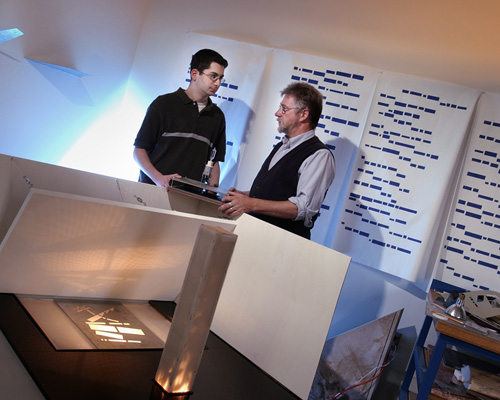In high school, Brian Finkelstein ’07 (Mendham, N.J.) had an active interest in art.
Unfortunately for the art world, he never pursued his love of sketching and sought his higher education in the field of mechanical engineering.
This summer, however, Finkelstein is returning to his artistic interests as he helps Alastair Noble, assistant professor of art, with an ongoing project to develop a public sculpture for the New Jersey Transit Authority in Wayne, N.J.
He also will help the artist complete a sculpture to be installed in Lafayette’s Williams Visual Arts Building at the end of August.
As an EXCEL Scholar, Finkelstein will transfer sketches of the sculpture into a computer program and, after the software fabricates a three-dimensional stencil of the artwork, he will help Noble cut the wood and aluminum pieces that comprise the artwork.
They are working together through Lafayette’s distinctive EXCEL Scholars program, in which students conduct research with faculty while earning a stipend. The program has helped to make Lafayette a national leader in undergraduate research. Many of the more than 160 students who participate each year share their work through articles in academic journals and/or conference presentations.
While it might seem strange for a mechanical engineering student to be dedicated to the creation and assembly of a sculpture, Noble has been building a bridge between the two departments, he says.
“There’s a much closer association between engineering and sculpture, structurally,” Noble says. “He has the background.”
Finkelstein agrees that his engineering background is crucial to the artistic process behind Noble’s particular technique, in which metal is cut into patterns that mimic the layout of a poem and creates the effect of a coded message.
“There’s a lot of engineering that goes into the design of the sculpture,” he says. “You need to design a base of the sculpture and the program itself is an engineering program.”
Finkelstein won’t argue that much of the work is new to him. The basic premise of Noble’s project is unique, he says.
“I might look at a piece of stainless steel with blocks cut out of it, for example,” he says. “Before, I would have walked by and not noticed it, but now, it makes sense to me.”
Even smaller, daily tasks have been a change of pace for Finkelstein, who hopes to walk away from his summer project with more than just new experiences.
“Basically, I want to learn the way things work in the real world, and to learn a lot of problem solving skills that engineers often come by,” he says.
Noble promises that the student will leave knowing much more.
“This will broaden his outlook on his abilities in engineering, building and construction, bridges, and how these kinds of things can be applied to arts,” he says.
Just as importantly, Noble says, Finkelstein is gaining real-world experience.
“We’re working in some ways on a collaborative basis,” Noble says. “I’m directing him on what to do, but I’m also listening to his contributions. He’s working almost in a professional capacity and that experience is valuable.”
Finkelstein is a graduate of West Morris Mendham High School.
As a national leader in undergraduate research, Lafayette sends one of the largest contingents to the National Conference on Undergraduate Research each year. Forty-two students were accepted to present their work at the last annual conference in April.

Brian Finkelstein ’07 helped Alastair Noble, assistant professor of art, create a public sculpture for the New Jersey Transit Authority in Wayne, N.J.
